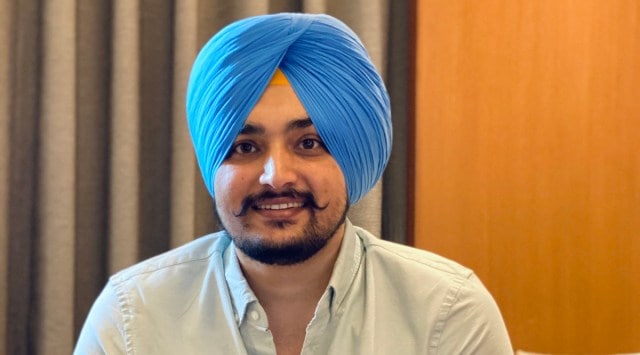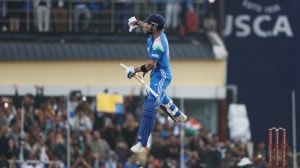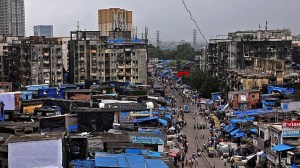Channel Z: Rooting for Panjab
‘My music is for Punjab and its people’, says Harwinder Singh Sidhu of Panj-aab Records & Brown Studios
 Founder and CEO of Panj-aab Records, Sidhu has now established Brown Studios which serves only artistes: Nimrat and Arjan Dhillon. (Express photo)
Founder and CEO of Panj-aab Records, Sidhu has now established Brown Studios which serves only artistes: Nimrat and Arjan Dhillon. (Express photo) AS a keen listener and lover of Punjabi music, a young Harwinder Singh Sidhu would often get together with his singer pals and tune in. Established, these singers (Sidhu would rather not name them), would reach out to him as a sounding board. “They would play their new songs, and I would play the audience,” he says. Now, it so happened, the songs he chose for release would turn out to be superhits. The litmus test would happen when the singer’s choice of song would fail to take off. Call it prophetic or pure luck, but clearly he not only had an ear for good music, but for a chartbuster one. “That’s when I decided to check out the music industry,” says Sidhu, who hails from a farming background and was working in Delhi in the petrochemical sector.
Trips to Chandigarh and Punjab started, as he visited musicians, record labels, checking out studios, music production – “how music is written, composed, shot, the entire drill.”
It was 2011-12, and the winner of Voice of Punjab was Nimrat Khaira. In the top ten was Ranjit Bawa and Sidhu knew this was the voice he’d bet on any day. A meeting with Bawa at the Amritsar university campus was arranged by a common friend, and an under-confident Bawa was on board. “We established Panjaab Records and successfully launched Ranjit Bawa in 2013,” says Sidhu, whose Panj-aab Vol 1 was a rocking hit. The album’s four tracks – Jatt di Akal by Bawa, Amrit Mann’s Jawla, Mehtab Virk’s Proposal and AK’s The Lost Life – proved to be running hits and launchpad for all these artistes.
Sidhu then went on to produce and release Diljit Dosanjh’s Jatt Fire Karda, Gippy Grewal’s Photo, Jass Bajwa’s Chakvi Mandeer among many other songs and artistes. But it was Nimrat Khaira who added ‘chaar chaand’ to his coterie. “Nimrat is very conscious of the songs she sings, of the image she portrays, it has to be clean, impactful and reflect Punjabiyat. She came with her father for the meeting, and in 2016 we signed her on.”
Founder and CEO of Panj-aab Records, Sidhu’s now established Brown Studios which serves only artistes: Nimrat and Arjan Dhillon. “Arjan approached us in 2017. He was from the medical stream, and an MA in vocal from Barnala. We connected, but I didn’t like the songs initially,” says Sidhu. But Arjan’s a writer, a lyricist whose words impressed Sidhu.
“For me, the music has to be for Punjab, about Punjab, of and from Punjab. It doesn’t matter whether it reaches or does well in the rest of the country, it has to be rooted here. Also, my focus has always been to listen to the song as an audience, not as a producer. A song will work if you feel like playing it again and again. A song will touch you if it speaks your language, your ma-boli, which I feel is missing. Our Punjabi language is getting corrupted with a Hinglish slang, and we are losing our virsa, our rich heritage of words and literature,” feels Sidhu. While the need for mild aggression and ‘josh’ in songs is a selling point, Sidhu’s effort has been to resuscitate the language. ”I’ve grown up on Manmohan Waris and Kuldeep Manak, beautiful songs from my childhood, and I want to give that to our people today.”
He makes an effort to compensate his writers and videographers like Preet Hundal, Navneet Buttar, Charan Likhari well, “for the songs we choose are also a gamble. Their hit status validates the artist.
Arjan Dhillon’s 15 track album is out, and songs are being released one by one, each reflective of Punjab. Sidhu is also looking at producing Nimrat’s films, and hopes to see more girls from Punjabi join the musical force, and female writers like Sukhwinder Amrit. “There is no strong culture of girls taking up music in Punjab, hence the dearth of female singers. Also, girls look for clean, soft, romantic songs, more saadgi, whereas the hits often are loud, aggressive, masculine. Nimrat has come up and set a new trend, and hopefully more girls will follow.”
Covid has changed Sidhu’s outlook too. He refuses to procrastinate, and insists on collaborating with the best. He also hopes to see Punjab move beyond just music. “Our industry is only about songs. We need to look at the world outside, people are doing so many things for their society, health, extra curricular activities. For instance, there is a culture of cycling, reading, trekking, camping abroad, and we need to encourage it here. On the entertainment front, we hardly have cinemas, most are either down south or in Gujarat and Maharashtra. Once we move away from communal talks and politics, art and culture will get the space to grow. Also, when governments start vewing art and culture as a business model, it will thrive.” It can.







